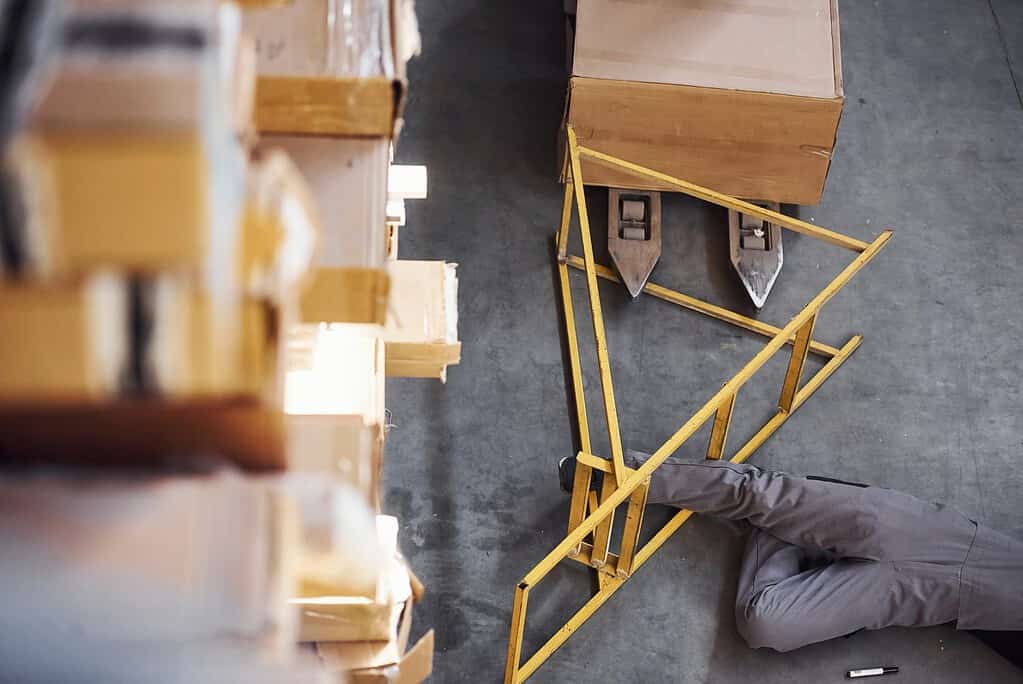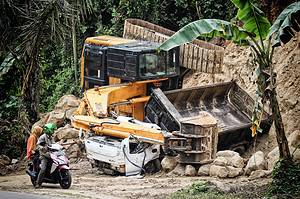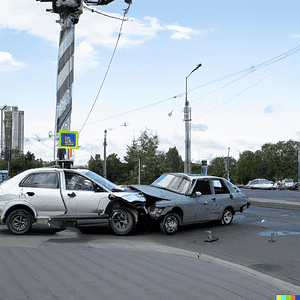A workplace accident is the last thing you wish to encounter when growing your business. Workplace accidents can cause physical harm, unwarranted stress, and problems for workers and employers.
Preventing workplace accidents requires a general understanding and awareness of the safety risks in your workplace. You can pair the knowledge with an accident prevention action plan to ensure the identified risks do not harm your workers.
So, what are the most common accidents in the workplace?
The most common workplace accidents are slips and falls, struck by moving objects, overexertion, motor vehicle accidents, workplace violence, fires and explosions, and hazardous chemicals.
In this post, we will explore these types of workplace accidents and offer recommendations on how to avoid them and keep everyone safe on the job.
Which Accidents are the Most Common?
Knowing the unique risks in your work environment is a crucial cornerstone of safety awareness. When you acquire this part of awareness, you can craft practical solutions for averting these accidents.
Here are the seven most common causes of workplace accidents.
1. Trips, Slips, and Falls
If you are wondering, “what is the most common workplace accident?” it must be slips and falls. Slips, trips, and falls account for a third of all workplace injuries. Approximately 244,000 employees missed work due to fall injuries in 2019.
According to the Centers for Disease Control and Prevention (CDC), slips, trips, and falls occur primarily because of:
- Slips: Occasional spills, wet surfaces, and weather hazards
- Trips: Poor lighting, clutter, uneven walking surfaces, and wrinkled carpeting.
These accidents can result in such injuries as cuts and lacerations, sprains and strains, and bone fractures. These accidents can lead to life-changing head and back injuries in severe cases.
2. Overexertion
Accidents occurring when a worker attempts to carry or lift heavy objects are called overexertion injuries. Picking a heavy object manually can cause muscle strains or lasting physical harm to a worker, ranging from lower-back injuries to chronic joint pain.
Overexertion can occur in a single incident but can also be cumulative, resulting from years of strenuous daily activities.
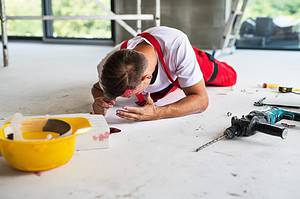
According to the BLS, overexertion accounts for 33% of occupational injuries and is the costliest of all work injuries. Back pain issues alone cost employers up to US$7 billion annually and lead to the loss of more than 100 million workdays.
3. Fires and Explosions
Fires and explosions at business premises are often caused by faulty gas lines, combustible materials that are not stored well, or open flames.
These accidents result in burns, respiratory problems, or disfigurement. Fires and explosions make up three per cent of work injuries and have the highest fatality rate compared to other workplace accidents.
The four injury types associated with fires and explosions are:
- Primary blast- Occurs due to pressure on body tissues (ears, lungs, and the GI tract).
- Secondary blast- Results when flying debris strikes adjacent workers.
- Tertiary blast- High-impact explosions.
- Quaternary blast- Anything else that can happen due to an explosion, such as crush injuries or burns.
4. Struck-by Objects
According to OSHA, approximately 50,000 accidents result from being struck by objects. Unfortunately, safety gear alone is enough to prevent these injuries.
A heavy object can fall, roll, or slide, striking a worker and resulting in injuries. For example, a construction tool can slip and crash on nearby workers.
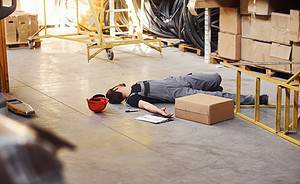
Being struck by a moving object can cause blunt force trauma or even traumatic brain injury if the object lands on a worker’s head.
Anyone working with heavy machinery is at risk of being struck, but these accidents are more common in factories with construction equipment and farm equipment.
5. Chemical Spills and Fume
Any exposure to harmful substances can result in work injuries and illnesses. Toxic chemicals can affect the skin, causing contact dermatitis. This condition alone accounts for 20% of all occupational diseases.
Chemicals like asbestos put workers at risk of cancer, while others like hydrochloric acid can corrode and destroy their skin.
Faulty gas lines or ill-fitting pipes can leak harmful gases or chemicals and cause respiratory damage.
6. Motor Vehicle Accidents
If driving is part of your job, you are exposed to weather conditions, defective automotive, or negligent drivers. Any of these factors can lead to car accidents.
Workers who spend the better part of their time around moving vehicles are also at high risk of getting hurt. For example, a warehouse or factory worker can be hit by a forklift. A construction worker can also be crushed by a tractor.
These vehicle-related accidents can leave workers with devastating injuries like spinal cord injury, head injury, or death.
7. Violence
Unfortunately, workers suffer injuries as a result of violent incidents in the workplace. A study by the BLS found that violence is the third leading cause of workplace fatalities.
Generally, any volatile exchange with a disgruntled co-worker or unsatisfied customer can lead to violence. A delivery person can also be assaulted by a customer or attacked by dogs.
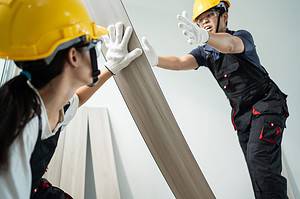
In cases of physical fights, a blow can land on the head and cause a concussion, brain hemorrhage, or even a skull fracture. The worst outcome of a punch to the head is that it can kill.
How Can These Common Accidents Be Avoided?
Any of the above workplace accidents can significantly impact your business. The costs can be dear, ranging from medical bills, lost productivity, and time consumed following up with workers’ compensation.
The best way to avoid these losses is by preventing workplace accidents. Here are some of the ways through which employers can prevent common accident hazards associated with the workplace.
a) Implement Control Measures
If you know the hazards your workers face, implement control measures to reduce the risk of these hazards causing workplace accidents.
There are different categories of controls that you can use, including:
- Elimination- Get rid of the hazard
- Substitution- Change the hazard
- Engineering controls- Separate employees from the hazard
- Administrative controls- Make changes to how work is done
- PPE- Provide personal protective equipment to workers
Let’s say you have an employee at risk of carpal tunnel syndrome because they spend most of their time on the computer. Offering them a wrist brace (PPE) would not be effective.
But administrative controls involving allowing them short, frequent breaks would be an effective solution. An even better solution would be to give them varying duties, so they are not restricted to making repetitive motions throughout the day (substitution).
b) Safety Training
A poorly trained employee is not only a danger to themselves but also other workers and third parties. Without adequate safety training, employees can unknowingly put themselves and everyone else in danger.
A thorough training program for every new employee, regardless of their experience, can help prevent workplace accidents. Even though they may take some time before being productive, you will protect your workers from harm and yourself from a potential lawsuit.
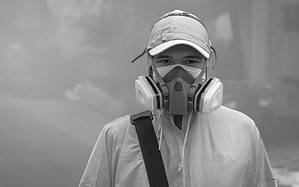
Another thing, conduct regular retraining sessions to keep employees up-to-date on policies and procedures. Depending on your industry, training can include:
- Proper lifting techniques
- Procedures for handling hazardous material
- Ergonomics
- Locations of emergency equipment like AED machines and fire extinguishers
c) Practice Good Housekeeping
A clean and organized work environment can help prevent slips, trips, and falls. Cleaning procedures should be part of the employee’s routine duties. Make sure workstations are clutter-free and have no spills or tripping hazards like loose rugs.
Warehouse and other manufacturing settings should have cleaning stations so workers can clean up quickly. These stations should be marked with signs and lights for workers to find them effortlessly.
d) Perform Regular Inspections
Using dangerous equipment is unavoidable in the construction, manufacturing, and repair industries. However, workplace accidents do not have to be part of the job.
Perform regular inspection of equipment, tools, and machinery. Everything that workers use should be checked to make sure they are safe and functioning correctly.

If something breaks, replace or repair it immediately. Saving a few dollars on a machine part may cost an employee’s health or your company thousands of dollars in legal fees.
Any company vehicles also need to undergo regular inspections and routine maintenance to keep them safe of operational, including:
- Oil change
- Tire balancing, rotation or replacement
- Brake system monitoring
- Windshield wiper replacement
e) Provide Protective Gear
Based on the nature of the work environment, employers may need to provide personal protective equipment (PPE) to keep their workers safe. PPE can include:
- Reflective vests or other high-visibility clothing
- Helmets
- Gloves
- Goggles
- Waist belts
New employees should also undergo training on how to use equipment properly. Consider carrying out unannounced safety audits to ensure your employees use PPE appropriately.
At What Point Do You Need Legal Help?
Employees who suffer workplace accident injuries are entitled to workers’ compensation benefits. The thing is, employers and insurance providers are familiar with workers comp and understand the process well.
Unfortunately, most injured workers are not familiar with it. If you go through this process alone, you can make a minor error leading to a denial of your worker’s comp claim.

Instead, you should seek the legal counsel of a workers’ comp lawyer as soon as possible after being involved in a workplace accident. Engaging a workers’ comp attorney early in the process can smoothen things out for you and yield better settlement awards.
In short, it’s never too soon to reach out to a lawyer.
Let Legal Giant Fight for You
No one should feel unsafe at work. Preventing accidents at the workplace is as essential for employers as it is for employees.
If you have been injured in a workplace accident, the support of an experienced workers’ comp lawyer can be priceless.
At Legal Giant, we connect you with experienced attorneys who are ready to represent workplace injury victims to help them recover compensation for their damages. Contact us today to get started.
